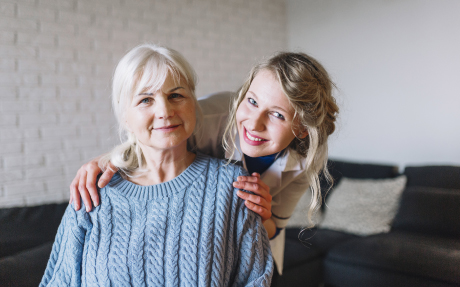More than ever, the need for caregivers has seen explosive growth as more people choose to age in place or choose to recover at home after surgery. Johns Hopkins defines a caregiver as someone who provides assistance in meeting the daily needs of another person. Caregivers are referred to as either "formal" or "informal."
"Formal" caregivers are paid for their services and have had training and education in providing care. This may include services from home health agencies and other trained professionals.
"Informal" caregivers, also called family caregivers, are people who give care to family or friends usually without payment. A caregiver gives care, generally in the home environment, for an aging parent, spouse, other relative, or unrelated person, or for an ill, or disabled person. These tasks may include transportation, grocery shopping, housework, preparing meals. Also giving assistance with getting dressed, getting out of bed, help with eating, and incontinence.
The family or friend caregivers present with unique challenges within the dynamic. Many provide care out of an obligation or because it is the right thing to do despite having their own lives and outside commitments. Trying to juggle these elements of responsibilities can quickly impair a well-intended plan or create strife within a household. Even more so, it is often difficult for the caregiver to recognize let alone verbalize, fatigue or burnout due to the relationship proximity to the loved one. Providing care in some situations can be all encompassing and leading to physical, emotional, and mental exhaustion. Some signs of fatigue leading to burnout include neglecting their own needs, irritability, weight loss, depression, and/or mood swings.
Caregiver.org finds that those who are more likely to rate physical strain of caregiving “high” are the following:
- Those providing care for a year or longer (23% versus 16% for less than a year);
- Older caregivers (23% age 65+ versus 17% age 18-49);
- Those who have a higher level of burden (31% versus 16%, of those with a moderate level of burden and 9% of those with a low level);
- Alzheimer’s or dementia caregivers (28% versus 17% for other caregivers);
- Those who are living with their care recipient (25% versus 17% who don’t live together). [National Alliance for Caregiving and AARP. (2015). Caregiving in the U.S.]
While the data may seem concerning, there are options to mitigate burnout such as alternating between family caregivers or hiring experienced (respite) help from an agency which can typically fill a need quickly to provide optimum coverage. Any concerns over the cost for hiring additional help are balanced by the overall well-being of the family caregiver and the loved one.
Caregivers are a foundational to the aging in place and health care ecosystem. As such, Castle Maven’s Caregivers Corner provides timely insights and shared stories as well as a place to connect to resources, learn and recognize that they are not alone. Utilizing agencies to help coordinate optimum care is essential to easing the burden leading to fatigue. Explore Castle Maven’s Telemedicine and Care category to find additional help for you or your loved ones.


